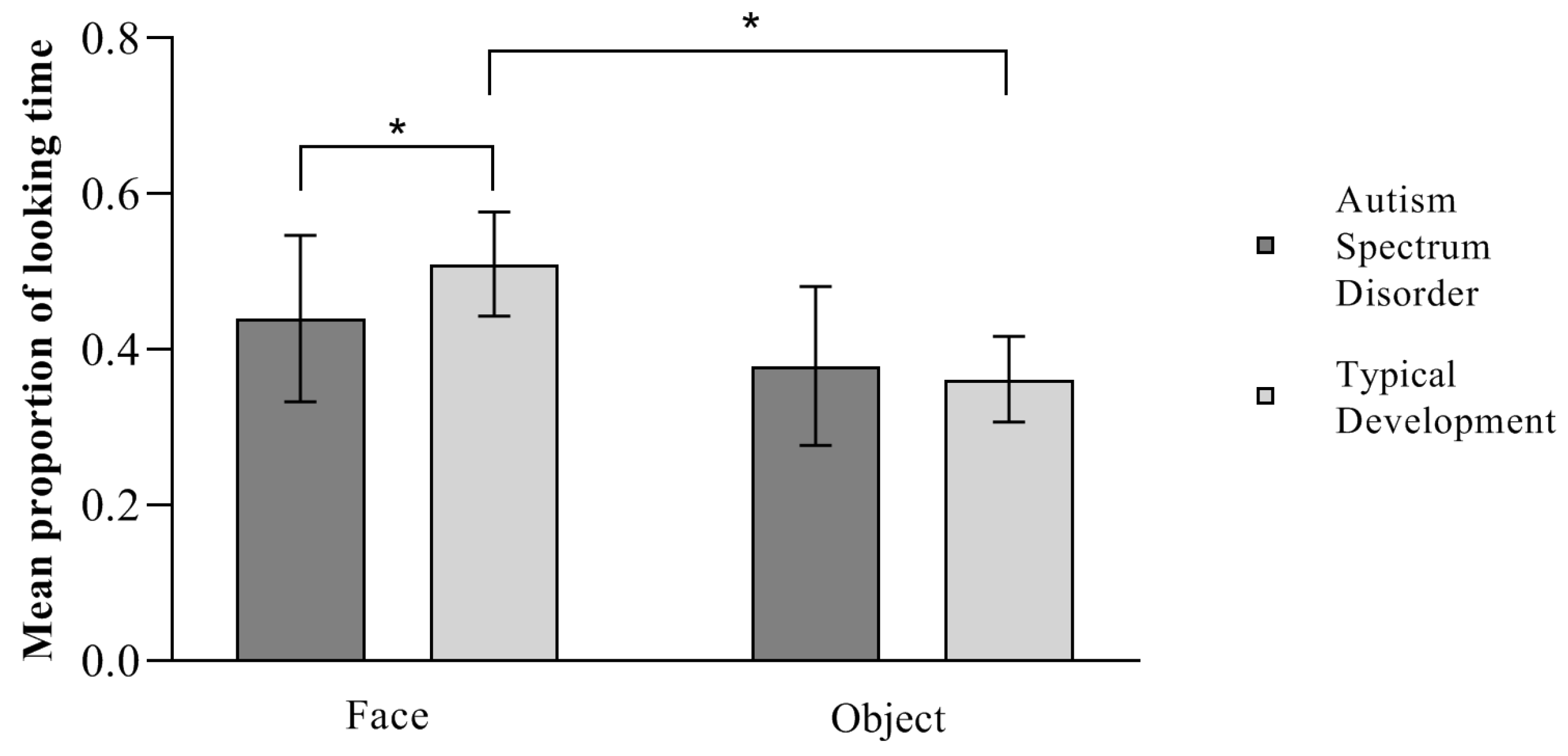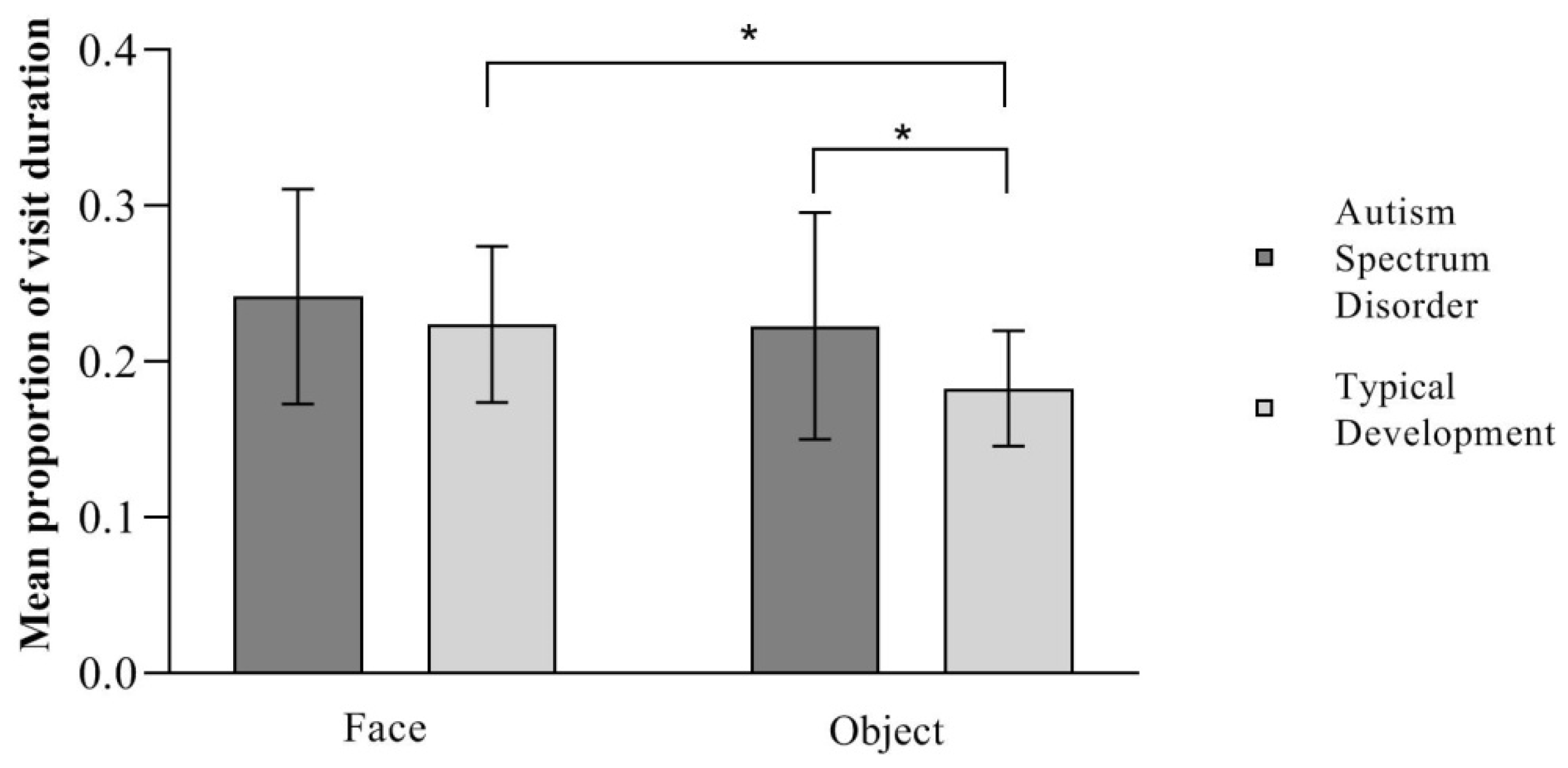Attention toward Social and Non-Social Stimuli in Preschool Children with Autism Spectrum Disorder: A Paired Preference Eye-Tracking Study
Abstract
1. Introduction
2. Materials and Methods
2.1. Participants
2.2. Stimuli
2.3. Apparatus and Procedure
2.4. Data Coding and Analysis
2.4.1. First Fixation
2.4.2. Total Visit Duration
2.4.3. Mean Time per Visit
3. Results
3.1. Statistical Analysis
3.1.1. Analysis of First Fixation Data: Prioritization
3.1.2. Analysis of Total Looking Time: Preference
3.1.3. Analysis of Mean Visit Duration: Sustained Attention
3.1.4. Correlation Analysis
3.2. Results of First Fixation Data: Prioritization
3.3. Results of Total Looking Time: Preference
3.4. Results of Mean Visit Duration: Sustained Attention
3.5. Results of Correlation Analysis
4. Discussion
5. Conclusions
Author Contributions
Funding
Institutional Review Board Statement
Informed Consent Statement
Data Availability Statement
Acknowledgments
Conflicts of Interest
References
- Morton, J.; Johnson, M.H. CONSPEC and CONLERN: A Two-Process Theory of Infant Face Recognition. Psychol. Rev. 1991, 98, 164. [Google Scholar] [CrossRef] [PubMed]
- Farroni, T.; Csibra, G.; Simion, F.; Johnson, M.H. Eye Contact Detection in Humans from Birth. Proc. Natl. Acad. Sci. USA 2002, 99, 9602–9605. [Google Scholar] [CrossRef] [PubMed]
- Frazier, T.W.; Strauss, M.; Klingemier, E.W.; Zetzer, E.E.; Hardan, A.Y.; Eng, C.; Youngstrom, E.A. A Meta-Analysis of Gaze Differences to Social and Nonsocial Information between Individuals with and without Autism. J. Am. Acad. Child Adolesc. Psychiatry 2017, 56, 546–555. [Google Scholar] [CrossRef] [PubMed]
- Klin, A. Young Autistic Children’s Listening Preferences in Regard to Speech: A Possible Characterization of the Symptom of Social Withdrawal. J. Autism Dev. Disord. 1991, 21, 29–42. [Google Scholar] [CrossRef] [PubMed]
- Osterling, J.; Dawson, G. Early Recognition of Children with Autism: A Study of First Birthday Home Videotapes. J. Autism Dev. Disord. 1994, 24, 247–257. [Google Scholar] [CrossRef] [PubMed]
- Dawson, G.; Meltzoff, A.N.; Osterling, J.; Rinaldi, J.; Brown, E. Children with Autism Fail to Orient to Naturally Occurring Social Stimuli. J. Autism Dev. Disord. 1998, 28, 479–485. [Google Scholar] [CrossRef] [PubMed]
- Osterling, J.A.; Dawson, G.; Munson, J.A. Early Recognition of 1-Year-Old Infants with Autism Spectrum Disorder versus Mental Retardation. Dev. Psychopathol. 2002, 14, 239–251. [Google Scholar] [CrossRef] [PubMed]
- Chawarska, K.; Macari, S.; Shic, F. Decreased Spontaneous Attention to Social Scenes in 6-Month-Old Infants Later Diagnosed with Autism Spectrum Disorders. Biol. Psychiatry 2013, 74, 195–203. [Google Scholar] [CrossRef] [PubMed]
- Jones, W.; Klin, A. Attention to Eyes Is Present but in Decline in 2–6-Month-Old Infants Later Diagnosed with Autism. Nature 2013, 504, 427–431. [Google Scholar] [CrossRef]
- Chita-Tegmark, M. Attention Allocation in ASD: A Review and Meta-Analysis of Eye-Tracking Studies. Rev. J. Autism Dev. Disord. 2016, 3, 209–223. [Google Scholar] [CrossRef]
- Ozonoff, S.; Macari, S.; Young, G.S.; Goldring, S.; Thompson, M.; Rogers, S.J. Atypical Object Exploration at 12 Months of Age Is Associated with Autism in a Prospective Sample. Autism 2008, 12, 457–472. [Google Scholar] [CrossRef] [PubMed]
- Sasson, N.J.; Elison, J.T.; Turner-Brown, L.M.; Dichter, G.S.; Bodfish, J.W. Brief Report: Circumscribed Attention in Young Children with Autism. J. Autism Dev. Disord. 2011, 41, 242–247. [Google Scholar] [CrossRef] [PubMed]
- Gale, C.M.; Eikeseth, S.; Klintwall, L. Children with Autism Show Atypical Preference for Non-Social Stimuli. Sci. Rep. 2019, 9, 10355. [Google Scholar] [CrossRef] [PubMed]
- American Psychiatric Association, D.; Association, A.P. Diagnostic and Statistical Manual of Mental Disorders: DSM-5; American Psychiatric Association: Washington, DC, USA, 2013; Volume 5. [Google Scholar] [CrossRef]
- Klin, A.; Jones, W.; Schultz, R.; Volkmar, F.; Cohen, D. Visual Fixation Patterns during Viewing of Naturalistic Social Situations as Predictors of Social Competence in Individuals with Autism. Arch. Gen. Psychiatry 2002, 59, 809–816. [Google Scholar] [CrossRef] [PubMed]
- Riby, D.M.; Hancock, P.J. Do Faces Capture the Attention of Individuals with Williams Syndrome or Autism? Evidence from Tracking Eye Movements. J. Autism Dev. Disord. 2009, 39, 421–431. [Google Scholar] [CrossRef] [PubMed]
- Nakano, T.; Tanaka, K.; Endo, Y.; Yamane, Y.; Yamamoto, T.; Nakano, Y.; Ohta, H.; Kato, N.; Kitazawa, S. Atypical Gaze Patterns in Children and Adults with Autism Spectrum Disorders Dissociated from Developmental Changes in Gaze Behaviour. Proc. R. Soc. B Biol. Sci. 2010, 277, 2935–2943. [Google Scholar] [CrossRef] [PubMed]
- Klin, A.; Lin, D.J.; Gorrindo, P.; Ramsay, G.; Jones, W. Two-Year-Olds with Autism Orient to Non-Social Contingencies Rather than Biological Motion. Nature 2009, 459, 257. [Google Scholar] [CrossRef] [PubMed]
- Sasson, N.J.; Touchstone, E.W. Visual Attention to Competing Social and Object Images by Preschool Children with Autism Spectrum Disorder. J. Autism Dev. Disord. 2014, 44, 584–592. [Google Scholar] [CrossRef] [PubMed]
- Chevallier, C.; Kohls, G.; Troiani, V.; Brodkin, E.S.; Schultz, R.T. The Social Motivation Theory of Autism. Trends Cogn. Sci. 2012, 16, 231–239. [Google Scholar] [CrossRef]
- Falck-Ytter, T.; von Hofsten, C. How Special Is Social Looking in ASD: A Review. In Progress in Brain Research; Elsevier: Amsterdam, The Netherlands, 2011; Volume 189, pp. 209–222. [Google Scholar] [CrossRef]
- Pierce, K.; Conant, D.; Hazin, R.; Stoner, R.; Desmond, J. Preference for Geometric Patterns Early in Life as a Risk Factor for Autism. Arch. Gen. Psychiatry 2011, 68, 101–109. [Google Scholar] [CrossRef]
- Pierce, K.; Marinero, S.; Hazin, R.; McKenna, B.; Barnes, C.C.; Malige, A. Eye Tracking Reveals Abnormal Visual Preference for Geometric Images as an Early Biomarker of an Autism Spectrum Disorder Subtype Associated with Increased Symptom Severity. Biol. Psychiatry 2016, 79, 657–666. [Google Scholar] [CrossRef] [PubMed]
- Rutherford, M.D. Social Attention Is Measurably and Increasingly Atypical across the First Six Months in the Broader Autism Phenotype. J. Psychol. Psychother. 2013, 3, 2161-0487. [Google Scholar] [CrossRef]
- Elsabbagh, M.; Gliga, T.; Pickles, A.; Hudry, K.; Charman, T.; Johnson, M.H.; the BASIS Team. The Development of Face Orienting Mechanisms in Infants At-Risk for Autism. Behav. Brain Res. 2013, 251, 147–154. [Google Scholar] [CrossRef] [PubMed]
- Vacas, J.; Antolí, A.; Sánchez-Raya, A.; Pérez-Dueñas, C.; Cuadrado, F. Visual Preference for Social vs. Non-Social Images in Young Children with Autism Spectrum Disorders. An Eye Tracking Study. PLoS ONE 2021, 16, e0252795. [Google Scholar] [CrossRef] [PubMed]
- Ambarchi, Z.; Boulton, K.A.; Thapa, R.; Thomas, E.E.; DeMayo, M.M.; Sasson, N.J.; Hickie, I.B.; Guastella, A.J. Evidence of a Reduced Role for Circumscribed Interests in the Social Attention Patterns of Children with Autism Spectrum Disorder. J. Autism Dev. Disord. 2023, 53, 3999–4011. [Google Scholar] [CrossRef] [PubMed]
- Harrison, A.J.; Slane, M.M. Examining How Types of Object Distractors Distinctly Compete for Facial Attention in Autism Spectrum Disorder Using Eye Tracking. J. Autism Dev. Disord. 2020, 50, 924–934. [Google Scholar] [CrossRef] [PubMed]
- Harrop, C.; Jones, D.R.; Sasson, N.J.; Zheng, S.; Nowell, S.W.; Parish-Morris, J. Social and Object Attention Is Influenced by Biological Sex and Toy Gender-congruence in Children with and without Autism. Autism Res. 2020, 13, 763–776. [Google Scholar] [CrossRef] [PubMed]
- Roid, G.H.; Miller, L.J. Leiter International Performance Scale-Revised (Leiter-R); Stoelting: Wood Dale, IL, USA, 1997; Volume 10. [Google Scholar]
- Lord, C.; Rutter, M.; DiLavore, P.C.; Risi, S.; Gotham, K.; Bishop, S.L. ADOS—Autism Diagnostic Observation Schedule; WPS: Los Angeles, CA, USA, 1999. [Google Scholar]
- Tarres, F.; Rama, A. GTAV Face Database. Available online: https://gtav.upc.edu/en/research-areas/face-database (accessed on 24 December 2010).
- Johnson, M.H. Subcortical Face Processing. Nat. Rev. Neurosci. 2005, 6, 766–774. [Google Scholar] [CrossRef] [PubMed]
- Macchi Cassia, V.; Turati, C.; Simion, F. Can a Nonspecific Bias toward Top-Heavy Patterns Explain Newborns’ Face Preference? Psychol. Sci. 2004, 15, 379–383. [Google Scholar] [CrossRef]
- Chawarska, K.; Volkmar, F.; Klin, A. Limited Attentional Bias for Faces in Toddlers with Autism Spectrum Disorders. Arch. Gen. Psychiatry 2010, 67, 178–185. [Google Scholar] [CrossRef]
- Grelotti, D.J.; Gauthier, I.; Schultz, R.T. Social Interest and the Development of Cortical Face Specialization: What Autism Teaches Us about Face Processing. Dev. Psychobiol. 2002, 40, 213–225. [Google Scholar] [CrossRef] [PubMed]
- Dawson, G.; Webb, S.J.; McPartland, J. Understanding the Nature of Face Processing Impairment in Autism: Insights from Behavioral and Electrophysiological Studies. Dev. Neuropsychol. 2005, 27, 403–424. [Google Scholar] [CrossRef] [PubMed]
- Rogers, S.J.; Dawson, G. Early Start Denver Model for Young Children with Autism: Promoting Language, Learning, and Engagement; Guilford Press: New York, NY, USA, 2010. [Google Scholar]
- Senju, A.; Johnson, M.H.; Csibra, G. The Development and Neural Basis of Referential Gaze Perception. Soc. Neurosci. 2006, 1, 220–234. [Google Scholar] [CrossRef]
- Esposito, M.; Mirizzi, P.; Fadda, R.; Pirollo, C.; Ricciardi, O.; Mazza, M.; Valenti, M. Food selectivity in children with autism: Guidelines for assessment and clinical interventions. Int. J. Environ. Res. Public Health 2023, 20, 5092. [Google Scholar] [CrossRef] [PubMed]




| ASD | TD | Statistical Comparison | ||||||
|---|---|---|---|---|---|---|---|---|
| Mean | SD | Range | Mean | SD | Range | t (df) | p | |
| Age (months) | 56.63 | 8.43 | 45–73 | 60.42 | 2.27 | 57–64 | 1.893 (20.59) | 0.073 |
| NVIQ Leiter-R | 110 | 13.38 | 90–133 | 109 | 10.69 | 90–126 | −0.244 (34) | 0.808 |
Disclaimer/Publisher’s Note: The statements, opinions and data contained in all publications are solely those of the individual author(s) and contributor(s) and not of MDPI and/or the editor(s). MDPI and/or the editor(s) disclaim responsibility for any injury to people or property resulting from any ideas, methods, instructions or products referred to in the content. |
© 2024 by the authors. Licensee MDPI, Basel, Switzerland. This article is an open access article distributed under the terms and conditions of the Creative Commons Attribution (CC BY) license (https://creativecommons.org/licenses/by/4.0/).
Share and Cite
Congiu, S.; Doneddu, G.; Fadda, R. Attention toward Social and Non-Social Stimuli in Preschool Children with Autism Spectrum Disorder: A Paired Preference Eye-Tracking Study. Int. J. Environ. Res. Public Health 2024, 21, 421. https://doi.org/10.3390/ijerph21040421
Congiu S, Doneddu G, Fadda R. Attention toward Social and Non-Social Stimuli in Preschool Children with Autism Spectrum Disorder: A Paired Preference Eye-Tracking Study. International Journal of Environmental Research and Public Health. 2024; 21(4):421. https://doi.org/10.3390/ijerph21040421
Chicago/Turabian StyleCongiu, Sara, Giuseppe Doneddu, and Roberta Fadda. 2024. "Attention toward Social and Non-Social Stimuli in Preschool Children with Autism Spectrum Disorder: A Paired Preference Eye-Tracking Study" International Journal of Environmental Research and Public Health 21, no. 4: 421. https://doi.org/10.3390/ijerph21040421
APA StyleCongiu, S., Doneddu, G., & Fadda, R. (2024). Attention toward Social and Non-Social Stimuli in Preschool Children with Autism Spectrum Disorder: A Paired Preference Eye-Tracking Study. International Journal of Environmental Research and Public Health, 21(4), 421. https://doi.org/10.3390/ijerph21040421






